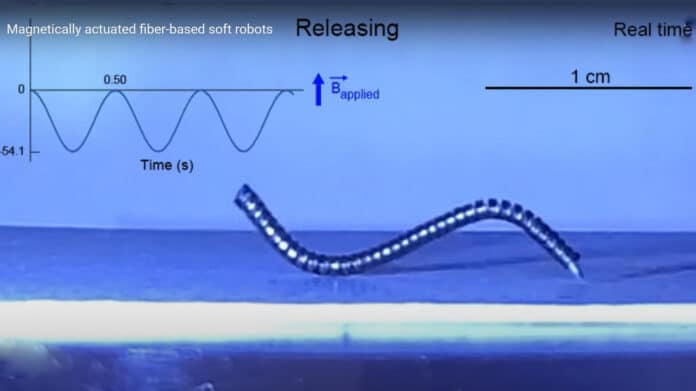Scientists at MIT have created tiny, soft-bodied robots that a weak magnet can control. These rubbery magnetic spiral-based robots may be designed to walk, crawl, and swim in response to a simple, easy-to-apply magnetic field.
Professor Polina Anikeeva, who is a professor of materials science and engineering and brain and cognitive sciences at MIT, a McGovern Institute for Brain Research associate investigator, as well as the associate director of MIT’s Research Laboratory of Electronics and director of MIT’s K. Lisa Yang Brain-Body Center, said, “This is the first time this has been done, to be able to control three-dimensional locomotion of robots with a one-dimensional magnetic field, And because they are predominantly composed of polymer and polymers are soft, you don’t need a huge magnetic field to activate them. It’s a really small magnetic field that drives these robots.”
The robots are well-suited to transfer cargo through restricted places, and their rubber bodies are soft in delicate environments, suggesting that the technology could be adapted for biomedical applications. The researcher and her team created millimeter-sized robots. However, she believes the same technology may be applied to create far smaller robots.
Youngbin Lee, Ph.D. ’22, a graduate student in Anikeeva’s group, devised a solution to this challenge by selectively magnetizing the robots in various zones and orientations such that a single magnetic field can enable a movement-driving profile of magnetic forces. Before the robots can be magnetized, their flexible, lightweight bodies must be created.
Lee begins with two types of rubber, each with a different stiffness. These are sandwiched and heated before being stretched into a long, thin fiber. Because of the differences in the qualities of the two rubbers, one retains its elasticity during the stretching process. At the same time, the other deforms and cannot return to its original size. When the strain is released, one layer of the fiber contracts, causing it to drag on the other.
A channel running through the elastic fiber contains a third substance whose particles can become magnetic. After the spiral has been formed, a magnetization pattern that allows for a specific type of movement can be added. According to the researcher, Youngbin carefully pondered how to magnetize our robots so they could move exactly how he intended them to.
The helical fiber is bent into mild undulations to form a caterpillar-like crawling robot. Then the body, head, and tail are magnetized so that a magnetic field applied perpendicular to the robot’s line of motion causes the body to compress. The compression is relieved, and the crawling robot expands when the field is decreased to zero. These actions, when combined, propel the robot forward. Another robot with two foot-like helical fibers connected by a joint is magnetized for more walking-like mobility.
She said, “Youngbin thought very carefully about how to magnetize our robots to make them able to move just as he programmed them to. He made calculations to determine how to establish such a profile of forces on it when we apply a magnetic field that it will start walking or crawling.”
The exact magnetization process provides a program for each robot. It ensures that the robots are simple to control after they are built. A weak magnetic field can send them differently if numerous robots are configured to go opposite directions. The scientists discovered that reversing the magnetic field has a valuable effect. A cargo-carrying robot can be persuaded to gently shake and release its contents by flipping a switch.
Researcher envisions these soft-bodied robots transporting items via tight pipelines or even into the human body, such as transporting medications through narrow veins. Magnetically-actuated devices have biological applications that extend beyond robotics and could be incorporated into artificial muscles or materials that promote tissue regeneration.
Journal Reference:
- Youngbin Lee, Florian Koehler,etal.Magnetically Actuated Fiber-Based Soft Robots.Advanced Materials. DOI: 10.1002/adma.202301916
